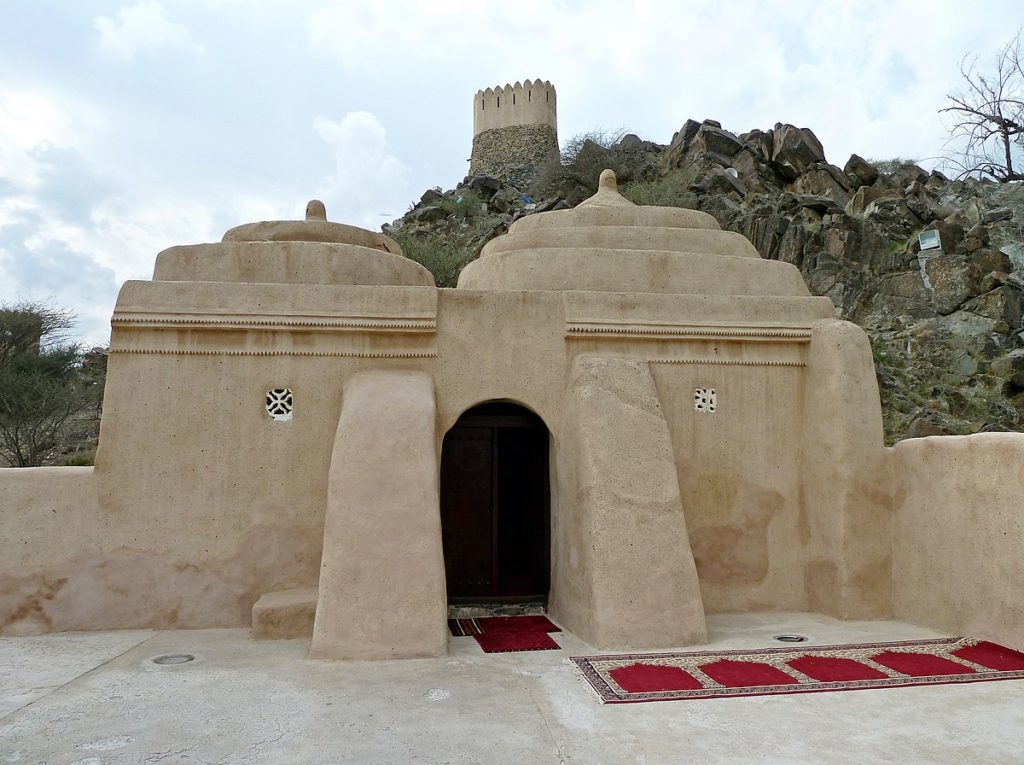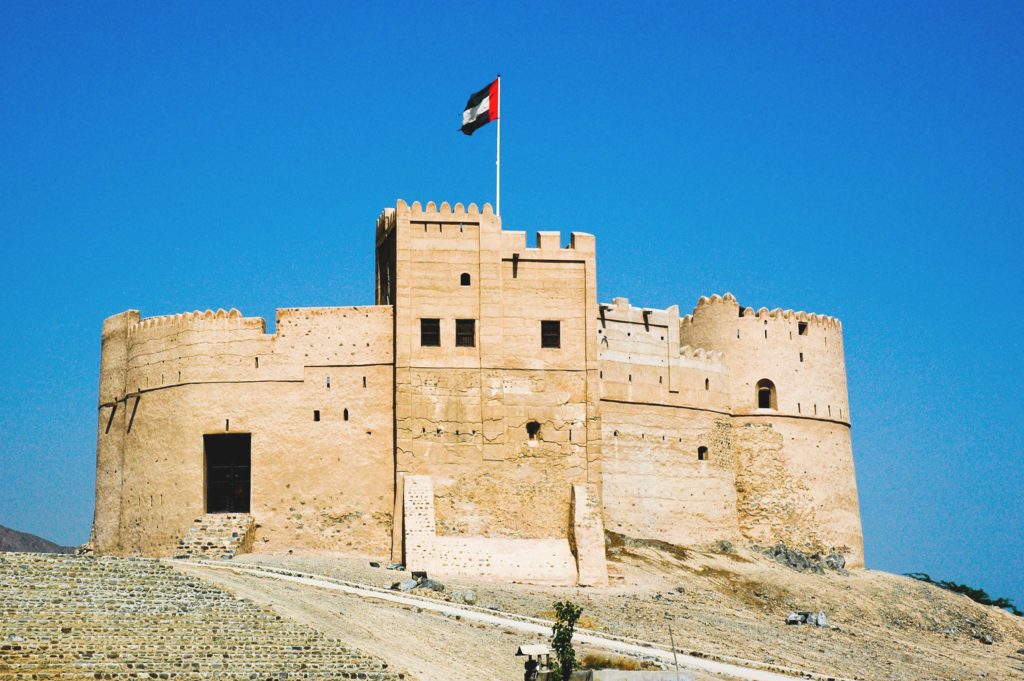By Muhammed Aladdin
It is not all skyscrapers and high-end restaurants; in fact, the UAE is one of the most heritage-rich destinations in the world. Prior to the discovery of oil and the economic boom that followed, life in the Emirates was much simpler, yet it was authentic.
Old mosques, bustling souqs, and pearl villages, the people of the UAE made sure to leave their footprint for future generations to see. Nowadays, the country still celebrates its history, dedicating a number of museums and heritage villages to it.
The monuments of this period in history are still there thriving all over the UAE, and it would be a shame if you are there and do not pay a visit. So, here is our guide to some of the historical hotspots in the Emirates.
Al–Badiyah Mosque

Located in Fujairah, Al-Badiyah Mosque is the oldest mosque in all of the UAE. Archaeologists believe that the stone-built worshipping house was established around the 15th century C.E.
Entrance to the mosque is through a double-winged wooden door that makes way to a prayer hall with a number of small decorative windows allowing air and light inside. Copies of the Qu’ran and other religious books are stored in cube-shaped space carved into the thick stone walls.
To this day, Al-Badiyah Mosque hosts the daily five prayers, allowing tourists to visit in between.
Al-Fahidi Fort – Now Dubai Museum

Considered to be the oldest standing building in all of Dubai, Al-Fahidi Fort was built in 1787; it was used to guard the town of Dubai and deter raiders.
In 1969, Sheikh Hamdan bin Rashed Al-Maktoum sent a letter to Sheikh Badr Mohammed Al-Sabah, Head of the Office of State in Kuwait, asking him to send an expert to Dubai to help with the establishment of the museum.
Today, the museum stands as an edifice of the traditional way of life in the Emirate of Dubai. It is home to a number of artifacts; the oldest dates back to 3,000 B.C.E. However, the majority is from the 1800s, including antiquities from Asian and African countries that used to trade with the port-city.
Bastakia Quarter

Perhaps, one of the oldest neighborhoods in Dubai, the Bastakia Quarter has been renovated to be one of the most beautiful attractions in the city.
To really appreciate its culture-rich vibe, you have to visit it at night when all the buildings are lit up. You’ll get to see the old Arabian architecture that used to dominate the city. Bastakia Quarter is the last remnant of Old Dubai, and how life used to be before the discovery of oil.
Dibba Village

The geographical region of Dibba is a coastal region at the northeastern UAE borders. It is politically divided into three parts; Dibba Al-Fujairah, ruled by the Emirate of Fujairah; Dibba Al-Hisn ruled by the Emirate of Sharjah; and Dibba Al-Baya, ruled by the Governorate of Musandam, Oman.
For as long as history remembers, Dibba’s natural harbor has been a major trading hub between a handful of cultures. The region is known for its myriad of relics and tombs that date back to the 7th century C.E.
In 2011, archaeologists discovered a pre-Islamic settlement with several artifacts that have been recovered, suggesting that there was early trade with both the Roman and Mesopotamian empires.
Al–Bithnah Fort

Thought to be built in the late 18th century, Al-Bithnah Fort is made of stone, mud-brick, and palm-wood planking. It is the second largest fortification in Fujairah, and perhaps, the most famous for its long history of battles and wars that took place between the end of the 18th and the beginning of the 19th centuries.
Al-Bithna Fort played a major role in deterring the invasions of enemies and protecting the city of Fujairah along with its people from a myriad of attackers and invaders. Today, the fort stands as a tourist attraction that tells stories of these turmoil times, reminding the people of the UAE of their unity in the face of danger.
Fujairah Fort

Dating back to the 16th century, the Fujairah Fort is one of the oldest castles in all of the United Arab Emirates. It has a long history of fighting back colonialist forces that tried to invade the country one wave after another.
It is composed of a castle, a mosque, and a number of old houses and is guarded by three watchtowers. Unfortunately, one of these towers was destroyed by the British Navy in 1925. However, between 1997 and 2000, the Administration of Antiquity and Heritage restored the fort using the same material that was originally used in its construction.
Al-Jahili Fort

Originally designed in 1891 to protect the surrounding palm farmers, Al-Jahili Fort is Abu Dhabi’s oldest standing fortification.
It has been restored by the Department of Antiquity and Museum in Al-Ain. However, the fort that is standing today is the product of the final restoration conducted by the Abu Dhabi Authority for Culture and Heritage.
It now includes a visitor’s office, a gift shop, and a public square for exhibitions and cultural activities.
Ras Al-Khaimah

The Emirate of Ras Al-Khaimah (RAK) has been blessed with a 9,000-year-old archaeological heritage. It is believed that the sweet water along its mountainsides and the rich diversity of its landscape attracted settlers throughout the different historical periods.
Ras Al-Khaimah is the only Emirate where fertile plains, high mountains, the coastal area, and desert come together in a distinctive combination. Such a unique interaction allowed a rich, diverse cultural background to thrive.
The Ubaid period, for instance, is one of the earliest evidence of human activity in the Arabian Peninsula. Archaeologists unearthed pottery, beads, net sinkers, and flint tools proving that humans migrated to Ras Al-Khaimah during the hot summer months.
Tombs and burial sites have been found all over RAK, along with pre-Islamic relics including weapons, coins, and a number of other artifacts.
Jazirat Al-Hamra

Jazirat Al-Hamra is a 19th-century ghost town located at the northernmost end of the UAE. The town is famous for its collection of abandoned houses and other buildings including a mosque.
In 1968, the townspeople moved to resettle in Abu Dhabi as a part of a government agreement; thus, the town that housed up to 2,500 people was suddenly left abandoned. Many of the UAE residents believe that it is haunted; nevertheless, it is a fully preserved page from a history book, and many tourists opt to visit it whenever in the Emirates.



